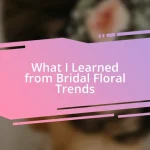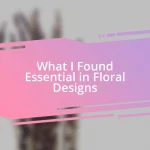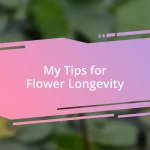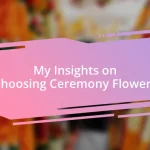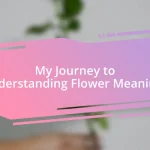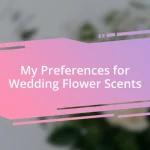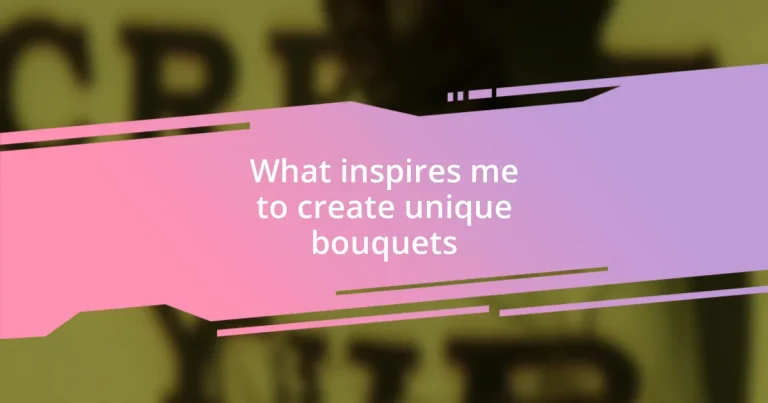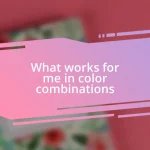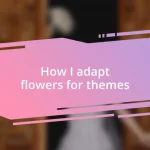Key takeaways:
- Bouquet creation is deeply influenced by personal experiences, emotions, and the beauty of nature, which inspire unique designs that reflect the creator’s journey and surroundings.
- Cultural traditions and the symbolism of flowers play a significant role in floral arrangements, encouraging a deeper connection and storytelling within each bouquet.
- Incorporating seasonal trends, personal touches, and unexpected elements can elevate floral designs, making them more meaningful and connected to the recipient’s personality and experiences.
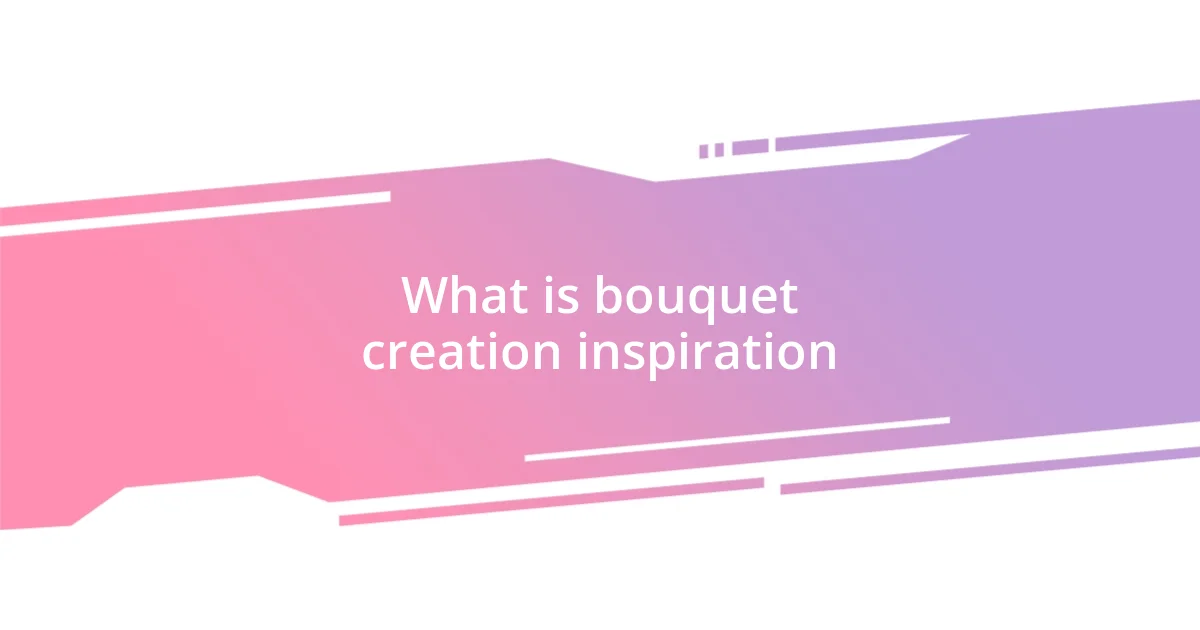
What is bouquet creation inspiration
Bouquet creation inspiration often springs from the beauty of nature itself. I remember a particular day when I was wandering through a local garden, feeling completely captivated by the vibrant colors and delicate textures of the flowers. Have you ever noticed how certain blooms evoke memories or feelings? That day, I was reminded of a childhood birthday party filled with laughter and colorful decorations, which fueled my desire to replicate that joy in my arrangements.
Another source of inspiration can be the emotions tied to specific occasions. For instance, crafting a bouquet for a wedding allows me to channel the love and hope surrounding the celebration. I find myself contemplating what flowers resonate with the couple’s story—often, I’ll ask myself, “What do they want this bouquet to express?” In those moments, I draw from my experiences, reflecting on the emotions that influenced my own choices in life.
Art and design also profoundly inspire my creations. I often turn to paintings, fabrics, or even architecture for fresh ideas. The subtle interplay of color and form in a piece of art can spark a whole new vision for a bouquet. Have you ever looked at a painting and felt an urge to capture its essence in a floral design? That’s the magic of inspiration; it’s everywhere, and sometimes it just takes a moment of observation to ignite that creative flame.
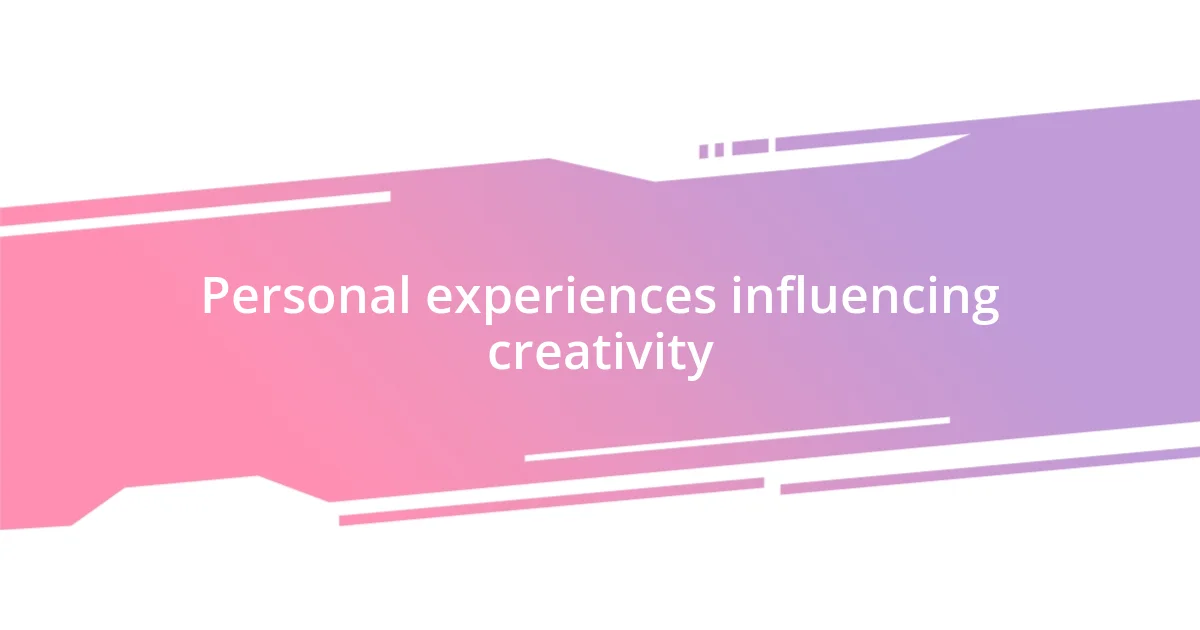
Personal experiences influencing creativity
Throughout my journey as a bouquet creator, I’ve encountered experiences that have shaped my creativity in unexpected ways. One occasion that stands out was a spontaneous trip to a sunflower field. As I stood enveloped by an ocean of yellow, I was flooded with pure joy. That immersion in nature reminded me how the simplest experiences can breathe life into my designs. The energy of the sunflowers inspired me to create bold arrangements that radiate warmth and positivity, parallel to what I felt that day.
Another influential experience occurred during a rainy afternoon spent with friends, sharing heartfelt stories. The mood was heavy with nostalgia, and I felt a strong pull to capture that closeness in my work. That’s when I began to explore softer color palettes and delicate blooms, reflecting the tenderness of those moments. Creating bouquets that convey emotion became a personal mission, as each arrangement transformed into a tangible expression of memories shared with loved ones.
I’ve realized that life’s most mundane experiences often spark my creative flames. A simple walk through my neighborhood, where I admire the variety of gardens, can trigger new ideas. For instance, observing a neighbor’s unique use of textures in their yard motivated me to incorporate more unconventional elements like dried flowers and twigs into my designs. This constant interplay between everyday life and my creative process ensures that my bouquets always feel fresh and personal.
| Experience | Influence on Creativity |
|---|---|
| Sunflower Field Visit | Inspired bold, radiant arrangements |
| Rainy Afternoon with Friends | Focused on soft colors and tender blooms |
| Neighborhood Walk | Incorporated unconventional elements |

Nature’s impact on floral design
Nature profoundly shapes my floral designs in ways that I find both subtle and inspiring. Each season brings a new palette and mood, inviting me to use colors and textures that reflect the environment around me. For example, while visiting an arboretum during autumn, I was mesmerized by the deep reds, oranges, and golds of the foliage, which sparked my creativity. That experience drove me to create a series of bouquets that mirrored those rich hues, embodying the warmth and vibrancy of fall.
- The transformative quality of light in different seasons—like the soft glow during golden hour—continues to influence how I arrange flowers, as each bloom takes on a life of its own in that light.
- Observing how flowers grow in nature, intermingling with their surroundings, encourages me to design bouquets that feel more organic, as if they naturally belong together.
- Visiting local gardens and public parks, I find inspiration in the unexpected combinations of blooms, which motivates me to experiment with new pairings in my arrangements.
When I wander through forests or along winding trails, the textures and scents around me deeply resonate. One memorable outing involved stumbling upon a wildflower patch amidst towering trees. The sight was astonishing—delicate blooms pushing through the earth, resilient against the backdrop of thick branches. That experience not only inspired me to incorporate wildflowers into my designs but also imbued my bouquets with a sense of wild beauty, reminding me that nature thrives in diversity. I often ask myself, “How can I recreate this feeling of spontaneity and wonder?” which leads to playful arrangements that mirror nature’s own artistic flair.
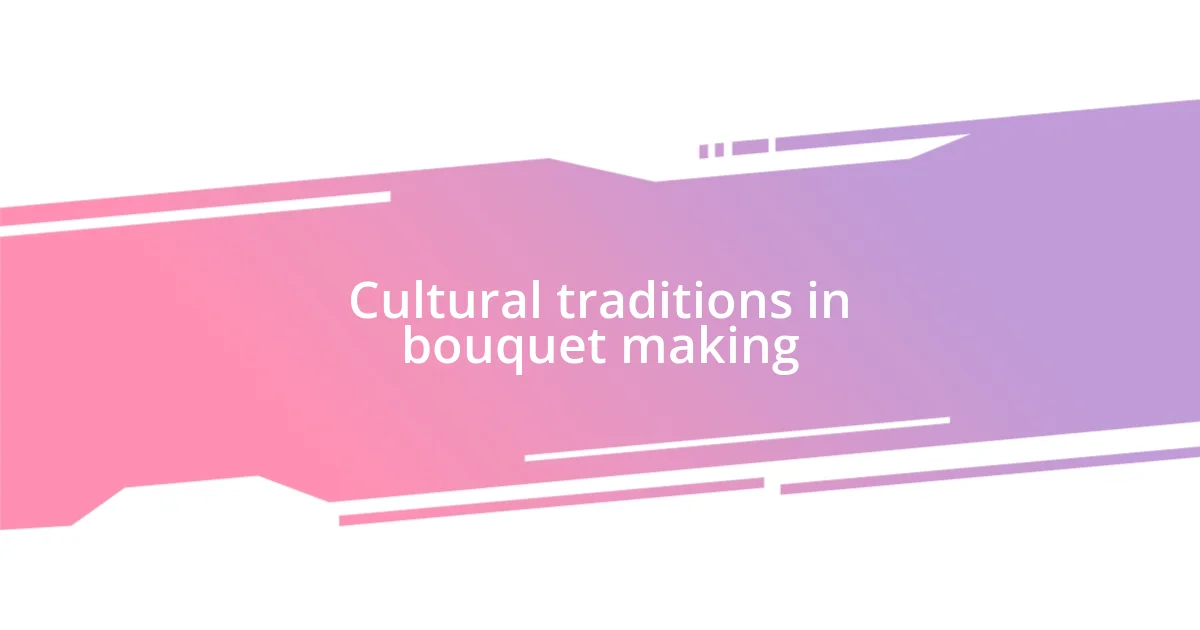
Cultural traditions in bouquet making
Cultural traditions play a significant role in bouquet making, influencing not just the choice of blooms but also the arrangement and symbolism behind them. For instance, during my travels to Japan, I was captivated by the art of Ikebana, where each flower is meticulously placed to convey harmony and balance. The mindful approach to each arrangement left me pondering: how can a simple bouquet reflect such deep cultural values? This experience pushed me to explore more intentional placements in my own designs, aiming to evoke a specific feeling or message.
I also remember attending a vibrant wedding in India, where the floral decor was a feast for the senses. The use of marigolds, often associated with celebration and auspiciousness, had a profound impact on me. The sheer joy of the guests and the richness of colors made me appreciate how flowers transcend mere aesthetics; they become vessels of emotion and cultural storytelling. It made me wonder, how can I integrate elements of celebration into my own creations?
Additionally, the traditional floral crowns of Mexico during Día de los Muertos deeply resonated with me. Each crown is laden with meaning, honoring those who have passed yet celebrating their lives. This concept of using flowers to express memory and connection inspired me to infuse my bouquets with layers of symbolism. I began to ask myself how I could weave storytelling into my arrangements, elevating them beyond beauty and into the realm of memory and legacy. Each culture has its nuances and depth, and these encounters enrich my understanding of floral design in ways I cherish deeply.
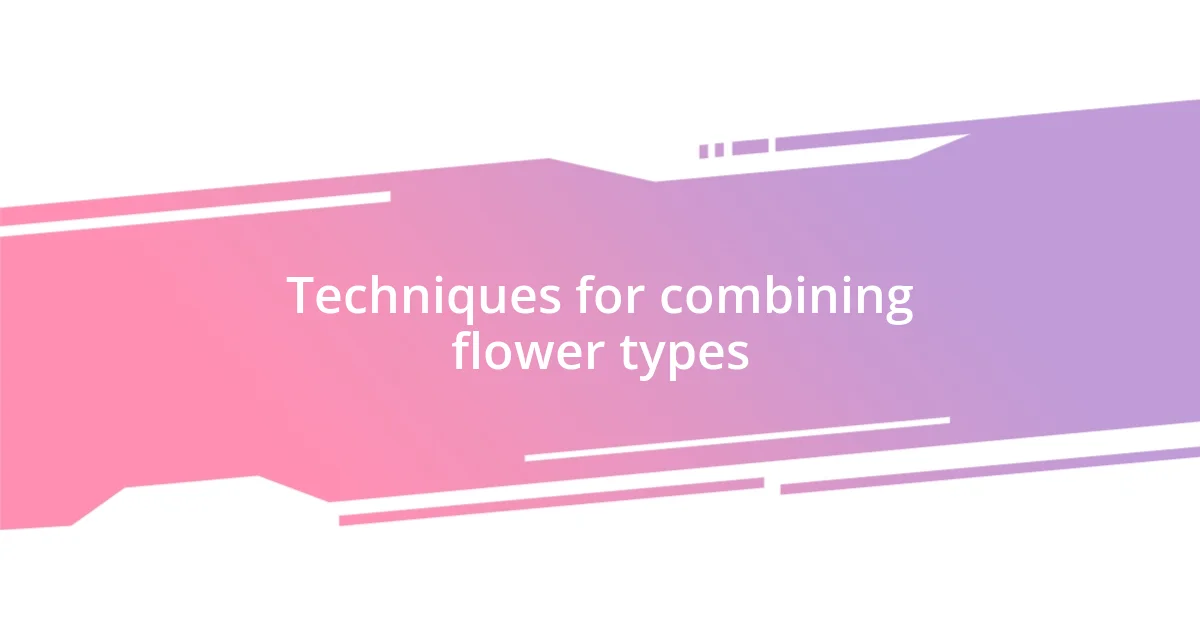
Techniques for combining flower types
Combining different flower types can be a delightful balancing act, and I’ve found that the key often lies in understanding their individual characteristics. For instance, heavy, robust blooms like peonies can anchor a bouquet and provide stability. On the other hand, delicate flowers like sweet peas add a light, airy feel. Have you ever considered how textures play a critical role? When I mix these contrasts, it creates a visual intrigue that invites the viewer in.
Another technique I often use involves considering color theory when blending flower types. Complementary colors can create vibrant energy, while analogous colors provide a soothing harmony. When I designed a summer bouquet featuring sunflowers with soft lavender and creamy white blooms, it resonated with me. The sunflowers brought warmth and cheer, while the lavender introduced a calming effect. It made me ponder, what emotions do I want the recipient to feel when they see my work?
Lastly, I’m always mindful of the seasonality of flowers. Some blooms simply don’t go together during different times of the year, both in their aesthetic and freshness. Last fall, I arranged a bouquet with dahlias and seasonal foliage—like colorful maple leaves—which made the entire arrangement feel alive and vibrant. Each type of flower brought its own story to the table, and I found myself reflecting on how those combinations speak to the cycles of life and nature we experience. It’s a reminder that flower arranging is not just an art; it’s a way to connect with the world around us.
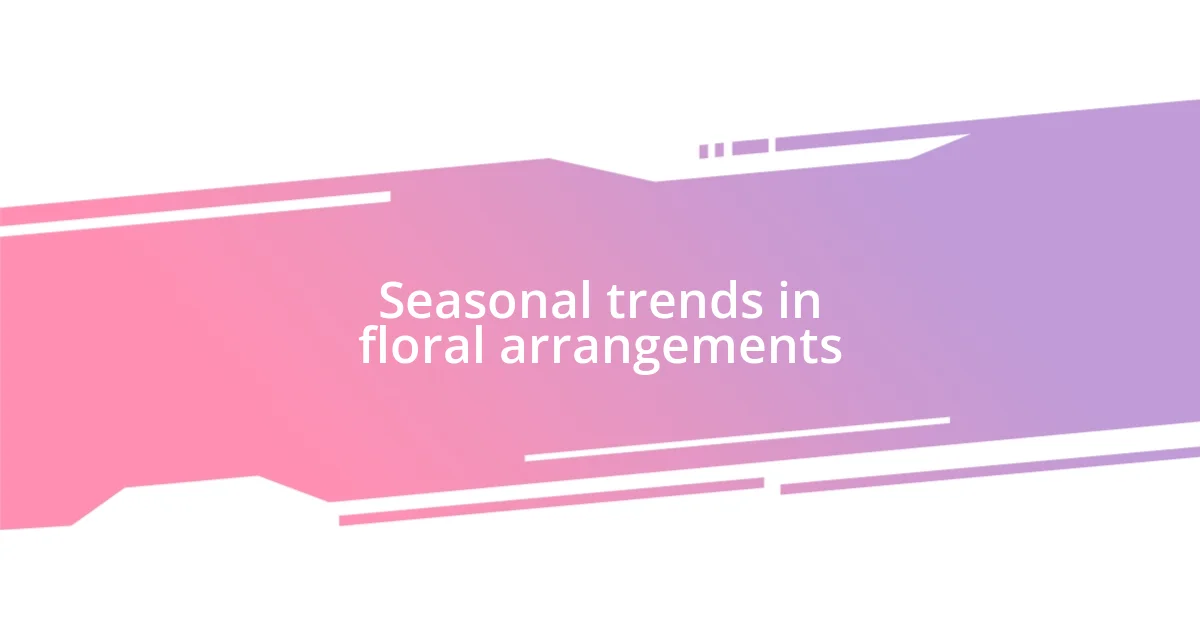
Seasonal trends in floral arrangements
I’ve always felt that seasonal trends in floral arrangements can breathe a fresh life into my designs. For instance, during spring, the vibrant burst of tulips and daffodils never fails to inspire me. I remember one sunny April morning, creating a bouquet filled with these cheerful blooms, which instantly lifted my spirits. It made me wonder, isn’t it fascinating how certain flowers can carry the very essence of a season?
As summer rolls in, I find myself drawn to the wild, untamed beauty of sunflowers and zinnias. There’s something about the bright yellows and oranges that evoke a feeling of warmth and exuberance. I once crafted a large bouquet for a summer bash, echoing the fun and relaxed vibe of the season. Watching the guests light up at the sight of those bold colors made me realize how seasonal blooms can truly capture and convey emotions.
When autumn arrives, my focus shifts to the rich, earthy tones of dahlias and chrysanthemums. I recall designing an arrangement for a cozy harvest dinner—using deep reds and burnt oranges that mirrored the falling leaves outside. The experience not only reflected nature’s transition but also brought a sense of warmth and comfort to the gathering. This led me to think: how can my arrangements evoke the feelings that each season embodies, creating an emotional connection with those who admire them?
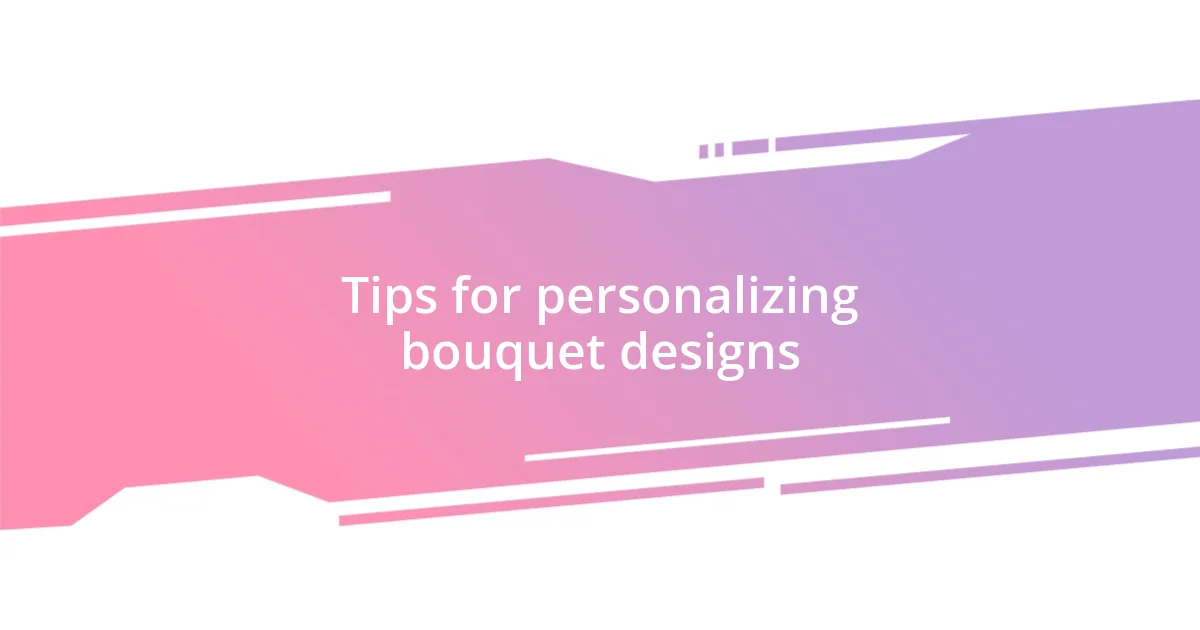
Tips for personalizing bouquet designs
Personalizing bouquet designs can truly elevate the experience for both the creator and the recipient. One of my go-to techniques involves incorporating elements that reflect the recipient’s personality or interests. For example, I once crafted a bouquet for a friend who adored the beach. I included seashells, delicate starfish, and soft blue hydrangeas that echoed the ocean’s waves. It created a beautiful and meaningful connection to her favorite memories. Have you thought about how small details can tell a story?
Another important tip is to consider the symbolism of the flowers you choose. Each bloom has its own meaning, which can be powerfully personal. I remember once designing a bouquet for a wedding, where I included lavender for devotion and rosemary for remembrance. The couple connected with those meanings, and I felt a sense of joy knowing that the bouquet would hold special significance for them on their big day. Isn’t it intriguing how flowers can convey messages that words sometimes cannot?
Lastly, don’t shy away from using unexpected elements to personalize your designs. I often experiment with adding non-floral items, like vintage brooches or twine, to create a unique texture and feel. I once transformed a simple arrangement by weaving in some handcrafted paper butterflies that reminded me of a lovely garden I visited years ago. This not only added a twist but also sparked conversations among friends who admired the bouquet. How do you plan to make your bouquet stand out? Personal touches can make all the difference and truly reflect the essence of your creation.

